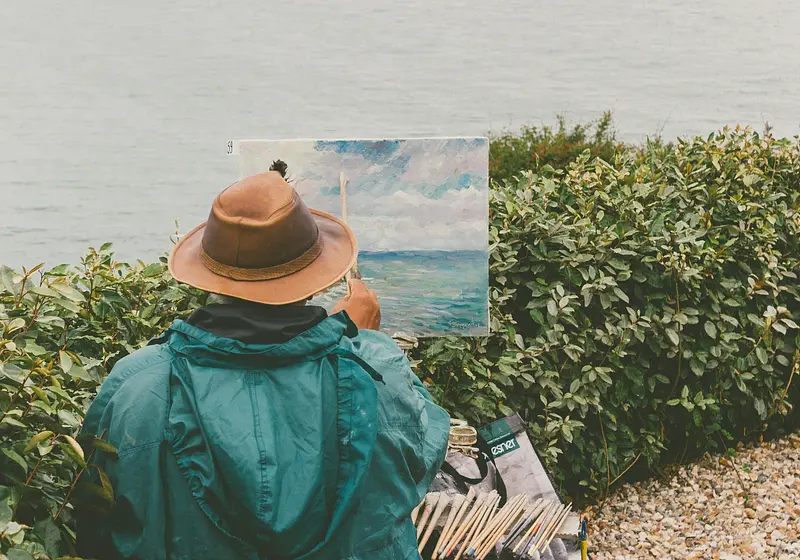Many argue that one cannot fit art into one definition that encompasses the entirety of its nuances. Our lives are parallels to a curious nature that whispers in our ears. We cannot escape art, for it is around us, whether it flies on a drying canvas or splatters on a sidewalk. While many definitions of art describe it as imprints of human creativity beyond using a functional object, it also includes phenomena of nature and human appreciation.
Art Within Life’s Patterns
Art hides in the circles that connect us all, whether through the nurturing of a mother’s womb or the soil that comforts the forgotten. It lurks in the sparrow’s nest, hiding a future generation in evergreen trees. One day, those eggs will hatch and soar as wingless birds, singing the same symphonies over centuries of the ones before them.
Like the melody of a sparrow’s song, art is within the compositions sung for thousands of years. It roars in the ashes of forever unread books, memories that perish like wilting roses. There is beauty in the forgotten stories that only the author could love. Art never forgets, yet seldom remembers how fragile it is.
The Fragility of Art in Societal Ills
One wrong turn in a ballerina’s dance, and the dancer crashes to the floor. Vases shatter into pieces when opposed to force. How could art be confined to human understanding? If one eliminates the naked eye, he will begin to fathom the intricacies of art.
Not to confuse art with intellectual blindness. With pristine sight, humans become ignorant of the invisible. The ignorant will never taste the nuances of sound or touch art’s fingertips.
Why have we become ignorant yet fear blindness? Both are parallels with one another, in which one cannot hear the complexities of a silent world.
What cures the ills of modern society cannot apply to art. It is a force that will never heal until heard, singing from the rooftops of voiceless neighborhoods. Nevertheless, it refuses to perish, even if the last painting vanishes from sight.
Why should mankind cure a sickling that never dies? As long as human thought exists, so will societal ills. There is miraculous art in this collective ignorance, which only the insightful explore.
The Laws of Art
While many lose sight of the artistic forces within their lives, others turn to the “wingless sparrows.” These are artists that fly above their perceptions. How do these artists soar above baseline thinking to contribute to artistic movements? Influential artists defy the laws passed upon them if one observes them closely.
Artists cannot indeed fly, yet this never stops their ink from gliding across a page. Stories from across the world bounce through the barriers of our languages to speak to us. Although wingless, artists are always lone sparrows soaring under an ebony sky.
The world’s job is to spectate them, considering the day it leaves contemporary thinking behind to reach new heights. Who should ever set the limits?
The primary law of art is understanding that it is not written. Instead, it must be transformed into new creations. Only when humankind collectively reaches this understanding will art have a core to the definitions established upon it. There are distinct connections between this nature and artists’ knowledge of its creation contained within their contributions.
The Concept of Time and Change
Several movements have expanded upon these foundations since humans grasped the concept of personalized creation and art. Art must have a broad definition instead of fitting into narrow categories that clump artworks together. In terms of artistic ideas, the line between whether art changes in its entirety versus expanding is blurred.
While our interpretations and trends in art shift according to movements and emphasized perspectives, art is fundamentally constant. While this may only apply to certain aspects of art’s nature, it incorporates human ideals on a seemingly endless landscape. Therefore, art is timeless and mirrors our world today.
The version humans have created adjusts to them by its laws and material creation. As a result, one may interpret a subject as art over another to which both pertain.
Our Experiences Shape Our Perceptions
Another reason art is complex to universally label is divided interests and perceptions. No two people hold the exact factions of their judgments. No artist can guarantee the circumstances of their viewers’ relationship with artwork.
As birds trust the instinct that they will fly, the brightest minds fledge from this world’s disorderly nest of perspectives to discover their own. Those who bear the same feathers will consider their creations as art.
As each viewer takes after another, society’s consensus will come to honor the artist. Yes, even then, there will be doubts about the artwork itself. Every artwork deserves a glance, but only the most daring will rise above our mere perceptions. An artist confronts our understanding of our inner worlds until every viewer finds a piece of themselves in the canvas.
A Glimpse of Art in Nature
Art would lie within human reach if it were reflected in nature. While the characteristics of Earth reflect an unexplored destiny of this universe, each person is born with an innate sense of art. Everyone universally understands the blood of violence, shed both by human hands and baboon fangs.
The longing for survival torments every living being; a warrior’s battle rages as a salmon’s struggle upstream. Each creature is similar, in which passion intertwines with innate knowledge.
Humans first discovered ways to foster the forces of art through natural resources. If created in modern times, humanity’s first pieces of artwork would now be considered abstract or even crude in art conventions. In the modern era, it is challenging to understand how ancient peoples (the original audience for these works) would have perceived cave paintings: we cannot verify why they were made, so we can only speculate.
Many cave paintings are deep inside caves, often in areas that are difficult to access. This suggests that these spaces might have been exclusive to a select few, or even perhaps not meant for a human audience but a spiritual one. From their experiences with nature, humans could depict elements of survival that dictated their daily lives. Therefore, universal forces and human instincts express art.
It may never be guaranteed that there will come a time when everyone collectively agrees on art’s true forms. Art lies all around us, whether through the Earth’s characteristics or the battle within human minds. It is despair and wisdom that hide the brilliance to which art abides. We must first be intellectually darkened so our understanding of art can come to light.




